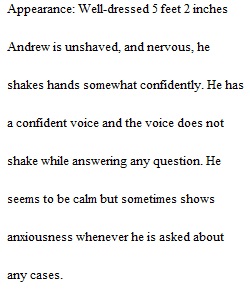


Q MENTAL STATUS EXAM One task in the initial interview is a gathering of information about the client’s mental status. You already have gathered background information in the initial interview. Now you are going to write up the Mental Status Exam (MSE) portion of that initial interview. In the initial interview report, you mainly focused of what the client revealed to you. For the MSE, most of what you report on will be based on your observations from that initial interview (appearance, behaviors, mood, affect, thought processes, etc.). These observations provide information about the client that is not readily discernable from the initial interview data. For this assignment, you will continue to use yourself or the character, or “alter ego,” that you interviewed for the initial interview. Remember, the client that you selected is a relatively well-adjusted individual who has already passed the initial interview process with the referring agency. Therefore, your MSE will mainly indicate functioning that is considered within the normal limits (WNL) of adaptive functioning. Your paper will be structured according to the headings provided in the Drummond text on page 310-11. This project must be 2–3 pages (excluding title page), double-spaced, APA formatted in a Word document, with no abstract. Important points regarding the Initial Interview: 1. Because the psychological evaluation was not be performed for clinical, forensic, or legal reasons, your character did not have a life-threatening medical condition, a chronic or debilitating psychological disorder, or an extensive criminal history. 2. Report all MSE information. The MSE is worth 100 points, so be thorough. Format of the Mental Status Exam: 1. Gather the MSE information using the categories from page 310-11 of the text and the “How to conduct a Mental Status Exam” handout. Report the information using the Mental Status Exam sample as a guideline. Remember, you will use this information for another project. Whether you decide to use the order found in the text, the handout, or the sample is up to you. However, make sure that you have all of the information. 2. Please make sure to note if the functioning is adaptive. For example, if no delusional thoughts are present, state it. If you do not specifically note this, the reader does not know if the client did not have delusions or if the counselor simply forgot to ask. 3. Written in the third person (e.g., “Mr. Jones is a 42 years old…,” “His greatest strengths are...”). 4. Your paper requires a title page (not included in the page count). Title the first page of your paper “Mental Status Exam”. Your report must be APA formatted. 5. Be sure that the information is consistent with the Initial Interview. Categories of Mental Status Exam from the Text Appearance: How was the client dressed and groomed (e.g., neat, disheveled, unkempt)? Behavior/Psychomotor Activity: Did the client exhibit slow movement, restlessness, or agitation? Did the client have any unusual behaviors such as tics, mannerisms, gestures? Attitude Toward Examiner: Was the client’s attitude toward the examiner cooperative, friendly, attentive, defensive, hostile, evasive, guarded, and so forth? Affect and Mood: Did the client have sad, angry, depressed, or anxious mood? Was the client emotionally responsive (affect)? Was affect congruent with mood? Speech: How was the quantity, rate of production, and quality of the client’s speech (e.g., minimal—mostly yes and no answers; talkative; rapid/pressured speech)? Perceptual Disturbances: Did the client experience hallucinations or illusions? If so, what sensory system did they involve (e.g., auditory, visual, olfactory, tactile)? Thought: Did the client have any disturbances in thought process, which involves the rate of thoughts and how they flow and are connected (e.g., racing thoughts, flight of ideas, tangential). Were there any disturbances in thought content, such as delusions, obsessions, preoccupations, or suicidal or homicidal thoughts? Orientation: Was the client aware of (a) the date and time, (b) where he or she was, and (c) who the people around him or her were (i.e., oriented to time, place, and person)? Memory: How was the client’s recent memory (e.g., what did he or she have for breakfast?) and remote memory (e.g., memories from childhood)? Concentration and Attention: Was the client’s concentration or attention impaired? Was the client distractible? Information and Intelligence: Can the client accomplish mental tasks that would be expected of a person of his or her educational level and background? Judgment and Insight: Does the client have the capacity for social judgment? Does the client have insight into the nature of his or her illness? Reliability: How accurately was the client able to report his or her situation?
View Related Questions